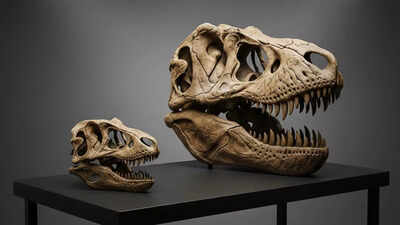Scientists have finally solved the ‘tiny’ T-Rex mystery |

If you ever wanted a courtroom drama where the jury consists of paleontologists, the defendant is a fossil, and the expert witness is a CT scanner, then welcome to the greatest dino trial since Jurassic Park made velociraptors the size of Great Danes. The 40-year mystery of the “tiny tyrant” has finally reached a verdict.For decades, scientists argued over whether a collection of small tyrannosaur fossils from the American West were teenage versions of Tyrannosaurus rex or a distinct species altogether. One camp said it was Teen Rex, the prehistoric equivalent of a hormonal adolescent with growth spurts and acne. The other swore it was Nanotyrannus lancensis, a separate species that just happened to look like T. rex’s fun-sized cousin.Now, a new paper in Nature has pulled the rug out from under the “teen theory.” Using fossils from the famous “dueling dinosaurs” collection, researchers Lindsay Zanno and James Napoli at the North Carolina Museum of Natural Sciences say the tiny terror was no kid—it was a full-grown adult.Cue the Jurassic Park soundtrack.
The dino trial of the century
For years, paleontologists have been stuck in a dino soap opera: was Nanotyrannus merely a moody T. rex that hadn’t yet hit its final growth spurt, or a unique species that evolution quietly buried? The debate got so heated it made Alan Grant vs. Ian Malcolm look like a polite academic chat.In 2006, everything changed when a Montana dig unearthed the “dueling dinosaurs”—a tyrannosaur locked in mortal combat with a triceratops. By 2020, the fossil had reached the North Carolina museum, where Dr. Zanno and Dr. Napoli could finally give the bones their day in court.They sliced into the bones (CSI: Cretaceous Edition), counted growth rings like tree trunks, and found something astonishing: the animal was around 20 years old. This wasn’t a gawky teenage predator still waiting for its prom date. This was a full-fledged adult.And it wasn’t a T. rex.
Exhibit A: The face of the defendant
Unlike the brutish T. rex—the Godzilla of the Late Cretaceous—Nanotyrannus had a longer, narrower snout, more teeth, and distinct nerve patterns in its skull. Its arms were slightly larger (finally, a tyrannosaur that could scratch its own nose), and it even had a hint of a third finger, as if evolution couldn’t quite let go of the past.The tail had fewer vertebrae, the skull was structured differently, and the whole anatomy screamed, “Different genus, your honour.”Dr. Zanno summed it up: “For it to change from that to an adult Tyrannosaurus would defy our knowledge of how vertebrates grow.” Translation: the Teen Rex theory just doesn’t hold up under cross-examination.
Enter the new species
The researchers didn’t just stop there. They re-examined “Jane,” the famous small tyrannosaur discovered in 2001, long thought to be a T. rex in training. Turns out “Jane” might be another member of the Nanotyrannus clan—newly christened Nanotyrannus lethaeus.In other words, there may have been multiple species of tiny tyrants roaming prehistoric North America, a whole family of featherless velociraptor wannabes hiding behind the shadow of Big Rex.This also upends decades of paleontological assumptions: maybe T. rex wasn’t the sole apex predator of its time. Maybe the Cretaceous wasn’t ruled by a single monarch, but a messy power struggle of cousins, rivals, and evolutionary oddities. Think of it less as Jurassic Kingdom and more Game of Bones.
Objection from the prosecution
Not everyone’s convinced. Thomas Carr, a Teen Rex loyalist, still isn’t buying all of it. He agrees the “dueling dinosaur” specimen is probably Nanotyrannus, but he questions whether “Jane” should be lumped in. His big problem? If all the smaller fossils are Nano, then where are the baby T. rexes?It’s a fair question. Every predator starts small, even the Cretaceous king. Maybe those juvenile T. rex fossils are still out there, buried beneath layers of Montana mud, waiting for some lucky grad student to find them—and start this argument all over again.But even skeptics admit the new paper is a seismic shift. Steve Brusatte, a former Nano doubter, called it a “mic drop.”
Life finds a way
So, what does this mean for the rest of us? Besides making the next Jurassic World rewrite half its script, the discovery changes how we see T. rex’s evolution. It suggests the tyrant lizards weren’t a single linear story but a sprawling family saga, full of dead ends and divergent experiments.And that’s the beauty of paleontology. It’s less about resurrecting dinosaurs and more about resurrecting arguments. Every fossil is a witness, every bone a clue, and every scientist a slightly exasperated Jeff Goldblum muttering, “Life… uh, finds a way.”So the tiny tyrant wasn’t a Teen Rex after all. It was its own thing, stomping through prehistoric forests with oversized hands and oversized confidence. The case of Nanotyrannus is closed.Until the next fossil takes the stand.
Discover more from stock updates now
Subscribe to get the latest posts sent to your email.











